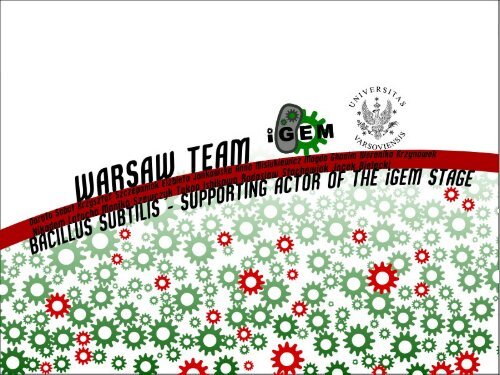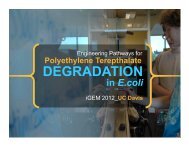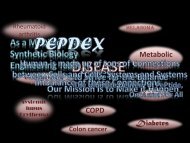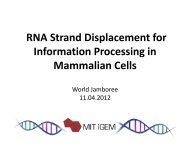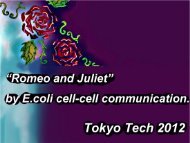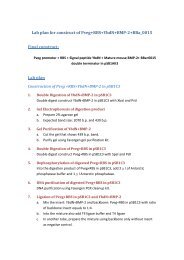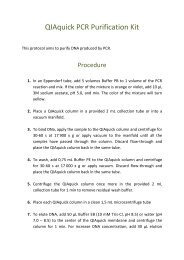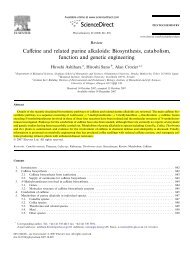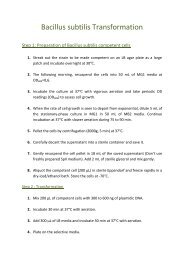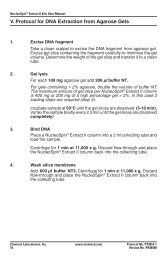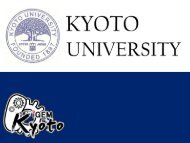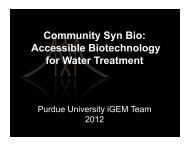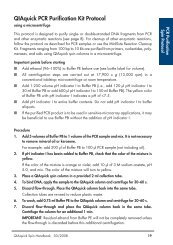Warsaw Presentation - iGEM 2012
Warsaw Presentation - iGEM 2012
Warsaw Presentation - iGEM 2012
You also want an ePaper? Increase the reach of your titles
YUMPU automatically turns print PDFs into web optimized ePapers that Google loves.
STARRING: BACILLUS SUBTILIS●A model gram-positive bacteria usedin synthetic biology●Only a few BioBricks available for it●Very interesting and challenging field●We aimed at creating more BioBricks for Bacillussubtilis which would encourage more teams toworking with it
WHY BACILLUS SUBTILIS WAS GIVEN THE LEADING ROLE?●The model bacterium of synthetic biology,Escherichia coli, is gram-negative●Listeria monocytogenes, which produces listeriolysinis a gram-positive bacterium●Differences in gene expression and protein functionbetween gram-negative and gram-positive bacteria●Listeriolysin has better performance in gram-positivebacterium
THE REST OF THE CAST;)
SCREENPLAY●Creating B. subtilis strain able to enter eukaryoticcells●Creating a mammalian vector capable of replicationand gene expression inside eukaryotic cell●Creating a shuttle vector which would work in bothprocaryotic and eukaryotic cells
SCREENPLAY - FIRST ACT(1) The bacteria carrying invasion vector wouldenter eukaryotic cells via phagocytosis
SCREENPLAY–FIRST ACT(2) Due to lysteriolysin activity it would escape fromthe phagosome before destruction(3) GFP fluorescencewould be used todetermine if bacteriasuccessfully enteredthe cytoplasm
SCREENPLAY - SECOND ACT(4) Lysis of B. subtilis cells would releasethe mammalian vector into the cytoplasmDue to oriP and EBNA1 gene the DNAmolecule would replicate andgenes present on it wouldbe expressed
SCREENPLAY - SECOND ACT(5) Measurement of fluorescent activity to confirmsuccess
SAFETY ON STAGE●Due to safety measures, we did not plan to combinethe two parts of our experiment. Each of the systemswould be tested separately●In the future, when the safety issues are solved, thedevice could be a great help in gene therapy
SCREENPLAY - THE FINAL ACT●The shuttle vector would work both ineukaryotic and bacterial cells●RFP flurescence measurement wouldprove its presence, replication and expression ineukaryotic cells●GFP would prove it is present in bacterial cells
MAKING OF THE MOVIEParts we cerated for B. subtilis:●Promoter : BBa_K780003●RBSes : BBa_K780001 and BBa_K780002●Terminator : BBa_K780000
MAKING OF THE BRICKS●We used a technique called primer annealing andextension
CHARACTERISATION OF NEW PARTS●We measured strength of K780002 RBS in E. colirelative to B0034 RBS
BUILDING OUR CONSTRUCTS●●Construct for B. subtilisBuilt on pTG262
●Mammalian construct
●Shuttle vector
OUR PRESENT RESULTS●●●●●●New promoter for B. subtilisTwo new RBSes for B. subtilisNew terminator for B. subtilisAll our parts could probably work in E. coliOne characterised RBS, measured in E. coliWe didn't manage to confirm all our constructs bysequencing, and we didn't want to send <strong>iGEM</strong> HQparts we weren't sure of
●●We couldn't successfully transform Bacillus subtiliswith our constructs, so unfortunately we didn't manageto end our project...We are sure that if we had more time and betterprocedure of transformation we could end our projectsuccessfully!
HAPPY END●In the future, when the safety problem will have beensolved this method could be used to provide genes tohuman cells with faulty genes●Example – phenylketonuria is a disease caused by adefunct gene coding hepatic enzyme phenylalaninehydroxylase, making it nonfunctional
BIOLOGISTS' NIGHTAn event in which manyPolish universities aretaking partThe main audience arehigh school studentsinterested in biologyOur Team educated young people about syntheticbiology and the <strong>iGEM</strong> project
'NUMBERS, COMPUTERS, LIFE'Organized byJagiellonian University inKrakówMembers of our teamprepared and gave apresentation aboutbasics of syntheticbiology and the <strong>iGEM</strong>competitionOne of the students wemet there became amember of our team:)
WE PUT 'HUMAN' IN 'HUMAN PRACTICE';)
2ND INTERNATIONAL SCIENTIFIC SEMINAR 'SCIENCE-SOCIETY-DIDACTICS'An event organized byPedagogical Universityof Kraków, aimed ateducating life sciencesteachers about differentapproaches to biologyOur advisor gave apresentation about novelapproach to syntheticbiology and the <strong>iGEM</strong>project
The audience at every event was very interested inscience, synthetic biology and the <strong>iGEM</strong> project itself.Their enthusiasm helped us during bad times in labwhen nothing was working as planned:P
OUR SPONSORS
OUR SPECIAL THANKS GO TO:●●Edinburgh Team, for sending us the pTG262 plasmidSlovenia Team, for sending us the CMV promoter
THANK YOU FOR YOUR ATTENTION!


